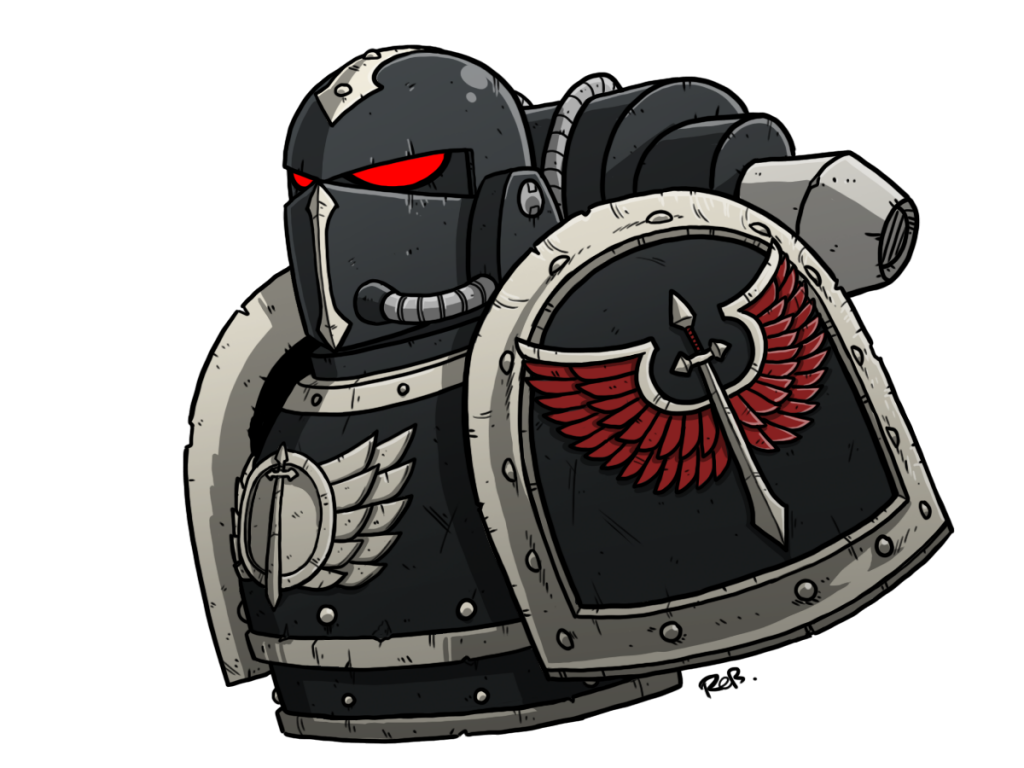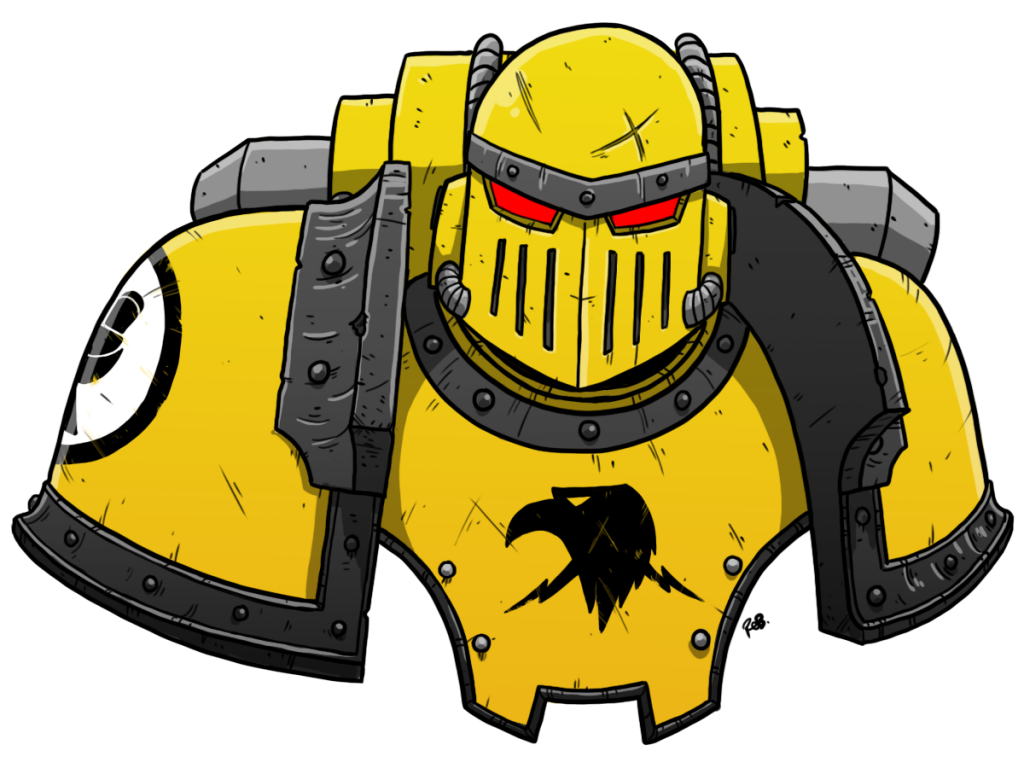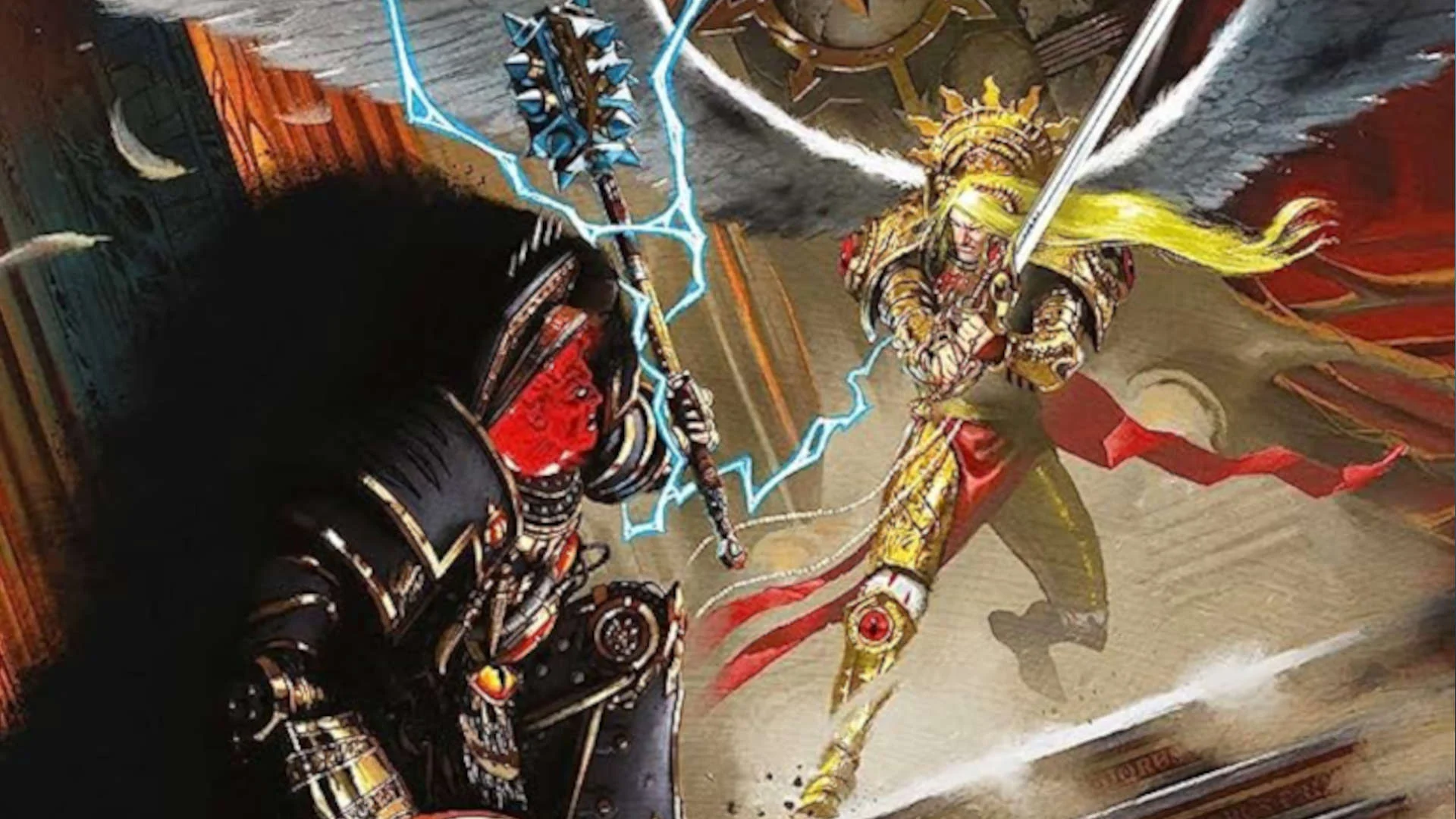We’re going to try and do this without spoilers – but if you haven’t read the End and the Death Part 1 at least, you may find some things spoiled for you a little. Where necessary, there’ll be a drop down box for very spoilery content. Open that at your peril!
So here we are. We’ve been to see the Elephant, and for nine long months the Emperor, Sanguinius, Rogal Dorn and Constantin Valdor have been frozen in the scant moments (or several hundred years) after arriving on the Vengeful Spirit. In all that time, particularly since the revelation that we would get three volumes of this one, single, book, I’ve wondered “What happens next?”
That could be the tagline for the book. On a surface level, there’s plot and twist and turn that’s all about what happens next. Then there was what is Abnett going to do next to turn Volume 2, where the plot could be so thin you could summarise it as “the bit with Sanguinius”, into another massive tome? On a business level, we inch closer to an end that must leave (or must have left) many in GW asking where they go now. Once I’d got to reading, I found that “what happens next?” is there on every page too, a thread of steel-sharp tension and drama that keeps us asking the question, more and more urgently, for hundreds upon hundreds of pages. What happens to us, as readers, as a business, as the millions of space marines, demi-gods, demons, soldiers, civilians, tech-priests and everyone else trapped down there on terra, next?
The answer, sadly, is “not a whole lot”.
However you ended up here, whether a long-standing veteran of tabletop and trader, a new recruit to Warhammer skipping to the end to read the last bits, or a dogged fan of the books alone, there’ll be something for you here to enjoy. This is another good Siege book. There’s lots of shooty-shooty, lots of choppy-choppy, demons explode all over the place, and cosmic truths of the 40k universe are either flat out revealed or slyly hinted at. You might already know the truth of it – it’s likely you’ll read this book, eventually. That makes this review a little pointless, but I wanted to write it anyway because I’m not sure you should read it.

Part 2 of 3 at least.
End and the Death Volume 1 was parts 1-4 of this final story, and Volume 2 brings us the next four parts. As we’re not about spoilers here, I’ll not take you through this beat by beat – I’m sure there’s other places you can find that. We open nanoseconds after (or before?) we left off, still trapped in the ever-burning now of the final moments of the siege. As shown in Volume 1, time and space have collapsed in upon themselves, and the first, weighty and dolorous half of Volume 2 keeps us in that terrible un-moment. From there, we spiral out into impossible spaces, vicious combats, moments of terror and violence and death innumerable, until the penultimate, fatal duel takes place, monstrous revelations are revealed and suddenly, crashingly, Volume 2 ends.
This very much is volume 2 rather than a sequel to the End and the Death, and there’s pros and cons to it in that. The stuff you liked in Volume 1 is still there – most of it. The stuff I liked mostly isn’t, which was sad for me, but then everyone else seemed to hate Malcador’s insane gothic rambling so that absence might improve the book for you. Horus is still excitingly in second person, the same strands of narrative and perspective are there – Sindermann, Keeler, Loken, Rann and Zephon et al – now joined with new ones, the perpetual gang wend their way somewhere. We still have multiple narratives, dozens of perspectives, and they are facing very much the same foes. It feels very much like Volume 2, rather than a second book in a trilogy.
Unfortunately, there’s been a good long while between the two, and someone has decreed that these books should be sold separately, at long remove. As a result, it’s neither a seamless handover as between volumes separated for ease of printing nor the iteration and improvement you might expect (or want) between original and sequel. As the multiple narratives pick back up, we’re eased in with what might be the best bits of the book where the interlude chapters give us Abnett writes Eldar, The Best Bits of Titanicus and C’mon Dan write us more space combat already, but then we’re back in the dirt of Terra and all the issues that plagued Volume 1 are back with a vengeance.

Good Guys
Before diving into those issues, there’s a lot of good, fun stuff here. Abnett is a trusted hand for Warhammer novels because he can do a couple of things exceptionally well. One, always, is combat. When Dan unleashes sword and bolter he’s got a wide playchest of styles and forms to do so with, and many of them are back at play here. There’s close-in hyperviolence, random brutality and horror, scientific, emotional and aetheric duels and, as always, they’re sections of adrenaline pumping transhuman nonsense, all good fun and exactly the stuff you imagine with you roll hot in a melee combat and your opponent fails all their saves.
Above and beyond the shooty stuff, Abnett has always had a knack for writing normal stuff to be weird and weird stuff to seem normal. As Terra falls apart, as the Vengeful Spirit and the Palace and somewhere suspiciously either Mordheim-or-Nottingham-esque begin to merge and phase through each other, Abnett goes full tilt at confusing, gothic, creepy and broken. Darkness scowls and pulls and purrs, buildings rot and crumble and loom, neverborn push their way into reality and are cast screaming back. Thick, vivid description of madness and the world gone bad is a strong thread from Volume 1 and it’s done better here, pared back a little and used for more concrete purposes.
The Third Pillar of Abnett’s core strengths in my opinion is character work. There’s a million characters here – the dramatis personae is, again, a dozen pages long (for aesthetic reasons only – most are in the book for a nanosecond, a single snatched line). Too many of these characters could be the same, marines whose distinguishing mark is just the colour of the armour, but Abnett puts the work in to make, and keep, them distinct. There’s less structure and language change than in Volume 1, and more work differentiating characters by what they say than by how they say it. Nasser Amit is, as he always is, a delight. Abaddon’s arc only gets clearer and cleaner. Sindermann sounds like he always has, and other characters layer on new narratives and thicken lore in their own distinct ways. Keeping so many characters distinct, over so many pages of dialogue, is an impressive achievement.

-4 to your Plot Armour Save
A lot happens in this book, but much more happened in Volume 1, both in terms of stuff, and in terms of meaningful stuff. I thought Volume 1 padded out its running time a little too much, and unfortunately so does Volume 2. While this second part is more coherent, dragging some light onto the mysteries of Volume 1, in the absence of mystery we’re not given resolution, but stasis. There are a dozen perspectives and hundreds of dangling plot threads Abnett has been tasked with cutting off, but there’s a point, surely, when you push back on that for the sake of your own narrative? We hop around too much, without really going anywhere, while one or two plots creak and groan their way forward in the background.
The plots that move forward are interesting and occasionally great. Sanguinius has a nicely done Virgil and Dante interlude before facing up to Horus in the great duel, which is done extremely well and worked to a satisfyingly gruesome end. We know Sanguinius has to die, and we know how he dies, but it’s still a fight worth reading about, even if you’re trying to work out exactly which hit Sanguinius gets in is “THE” hit. Dorn gets some of the most interesting sections of the book that play with the bounds of the warp in interesting ways. Valdor gets his setup for another series, and I can’t begrudge him, or Dan, that opportunity. Even the Perpetual gang start doing something interesting. The content that means something in this book is great – but it’s also thin. Standard BL novel sized, at most.
Other plots you could drop and lose nothing – or visit once, instead of four, five, a dozen times, throughout the novel. It’s nice to see Sigismund again, but his narrative arc was completed a few books ago and retreads old ground here. Fo is a bafflingly long side-show that provides some great seeds for a 40k RPG and seems to be setting up for a Scouring series more than providing compelling plot here. Others are duplicates, loyalist/traitor mirrors. Taking an axe to some of these threads, leaving them in the red snow, would, in my opinion, make for a better book.
Unfortunately if we’re talking about dropping plots, we have to talk about one in particular. Here’s a big spoiler for one of the most exciting things that Volume 1 tantalised us with – the Dark King. Expand this at your peril.
MAJOR SPOILERS IF YOU CLICK HERE, LEGIT
This is an enormous book where the plot is revealed, discussed and ended in a sliver of it so small you could forget it happened at all. It’s dropped, swiftly and possibly terminally, and the Emperor goes back to being the Emperor. This changes precisely nothing – it’s a plot reset that makes the entirety of Volume 2 pointless. No one has changed, because this was an accident. The emperor went too far, but he can be restrained, and he choses self restraint, so nothing has changed at all. We have travelled nowhere, learnt nothing, had no new experience, and returned to the default we expected in Volume 1.
In nearly all respects we have come full circle to the end of Volume 1, with the principal players drawn to the Vengeful Spirit to have the final battle. After god-knows-how-many-pages, we are exactly where we were in February. We have learnt more context, perhaps put Volume 1 into focus a little better, taken the edge off of some of its mysticism and mystery, but in doing so you’re left wondering why make one unfocused, wandering maze of a book (because it’s cool!) then immediately close it all up in the second section? Why reset the game 2/3rds of the way through? When time stops in the novel, the plot stops. Nothing has changed, bar a single piece taken off the board.

Wrapping Up
Unfortunately, for me at least, all the fun stuff and the bits that are a fantastic reminder of why Dan Abnett is such a master of Warhammer fiction don’t quite add up to satisfying middle section of a single epic novel.
There’s a couple of reasons why, but the main one is that time-stop. It’s a nice conceit, and one that was explored well in Volume 1. Bringing us back to it is a good refresher of how fucked up Terra has become. Keeping us in that feeling creates and reinforces the powerful sense of time-gone-wrong. But then we’re kept in it. And kept in it. And kept in it. A third of the book – if not more – is dedicated to endlessly experiencing the same moments from a dozen perspectives.
We were trapped in this narrative structure in Volume 1, too. Much of the latter half of that book was exploring how, say, Zephon and Rann experience time and space warping around them. In this book we get Amit’s perspective too. And then Rann’s again. And Keeler’s. And, and, and, and… Eventually every character has to painfully arrive at what we already know from Volume 1: time and space are messed up in the palace. Everyone has to be surprised that a landmark isn’t where they thought, some of them several times. Every marine character must be outflanked by traitors coming out of the walls. Every traitor must appear out of nowhere in a place they didn’t expect. As a narrative device, it’s great and clever for a while, trapping the reader in the same terrible moment of madness. But it was great and clever in February, and it grows thin long before it stops happening.
Part of this feeling that both characters and readers are trapped in a hell without exit or end comes from the incredibly rapid-fire chapter structure, where only at the very beginning and very end do you get passages of narrative longer than 2-3 pages (kindle user here, so your milage may vary on the exact size). There’s a real benefit to that, a kind of hyper-kinetic flipping between so many perspectives, writing-as-avengers-battle, but instead of the kind of zip and fervour of breathlessness you want, there’s a staid ponderousness. We move between perspectives but the chapters never move on when we’re not looking. We are trapped in the moment still, so we hear every word, every second, and it shackles our characters – transhuman monsters, godlings and humans alike – to a snail’s pace. They wade through the narrative like it’s treacle – another clever fusion of our world and written world, but another one that costs the reader and the narrative too much to be worth paying because while in their world they’re stuck, we aren’t.
All this is clever, but it’s just done too much, too often, and it really isn’t clever enough to make it worth it. In writing this, I feel the need to stop and justify myself, to readers and, I suppose, to Dan Abnett. I feel like I should point to untold hours of reading epic fantasy and sweeping SF, the years spent hammering through tomes written as if the author was being paid by the page, because the inevitable accusation is “well, you just don’t read long /complex books” and I want to assure you that I do. I’m not happy with what that says about my self confidence, if I’m honest.
The End and the Death (vol 1 and 2) is pointlessly long and it suffers for it. It is length for the sake of making this three volumes, perhaps to give it a sense of worth-via-length, or to satisfy someone’s desire to have “one of the world’s longest SF novels” in the Black Library stable, or, and this is cynical of me, to make us buy three of them instead of two. It suffers for its length in a way that other massive, dense epics of SF and fantasy do not, because the endless repetition isn’t a good read. It would make a good art project – you could narrate all the simultaneous moments together in one howling cacophony of war and demons and gods, echoing off a strobe-lit room in deep in the Tate modern, but it isn’t that. It approaches the kind of dissolution of narrative in the face of time that Burroughs and Delaney nailed in their fiction, but they had the cut up method and a shitload of drugs. It seems to draw a lot from Grant Morrison, either in his mainstream DC days (I’m told Final Crisis is very similar) or from the Invisibles, but Morrison had the wide open space of comic art to play in. Dan has the strict boundaries of what the BL will publish and an inhuman weight of expectation, perhaps necessitating this approach as the closest thing to a non-linear, experimental narrative form that would be approved for the BL’s audience. So it works hard at being cyclical, at returning to madness, at keeping us stuck in the moment until the moment resolves, but it just doesn’t quite work.
It’s impossible to judge this as a standalone book, because it isn’t that, but even as the middle section of an epic it sags and buckles under the weight of expectation and the time/space shenanigans that become central to the story. It doesn’t reach the heights of Vol 1, perhaps even undermining some of the best bits of it, and shares the same lows while getting stuck in new ones it struggles to surpass.
In the end – or close to it – End and the Death simply isn’t a great book. If you’ve got this far in the series you’re going to read it anyway – but that isn’t an argument in its favour. On to Part Three. May the Dark King bless us all.
Questions, Comments, Suggestions? Contact@goonhammer.com, or leave a comment below.


